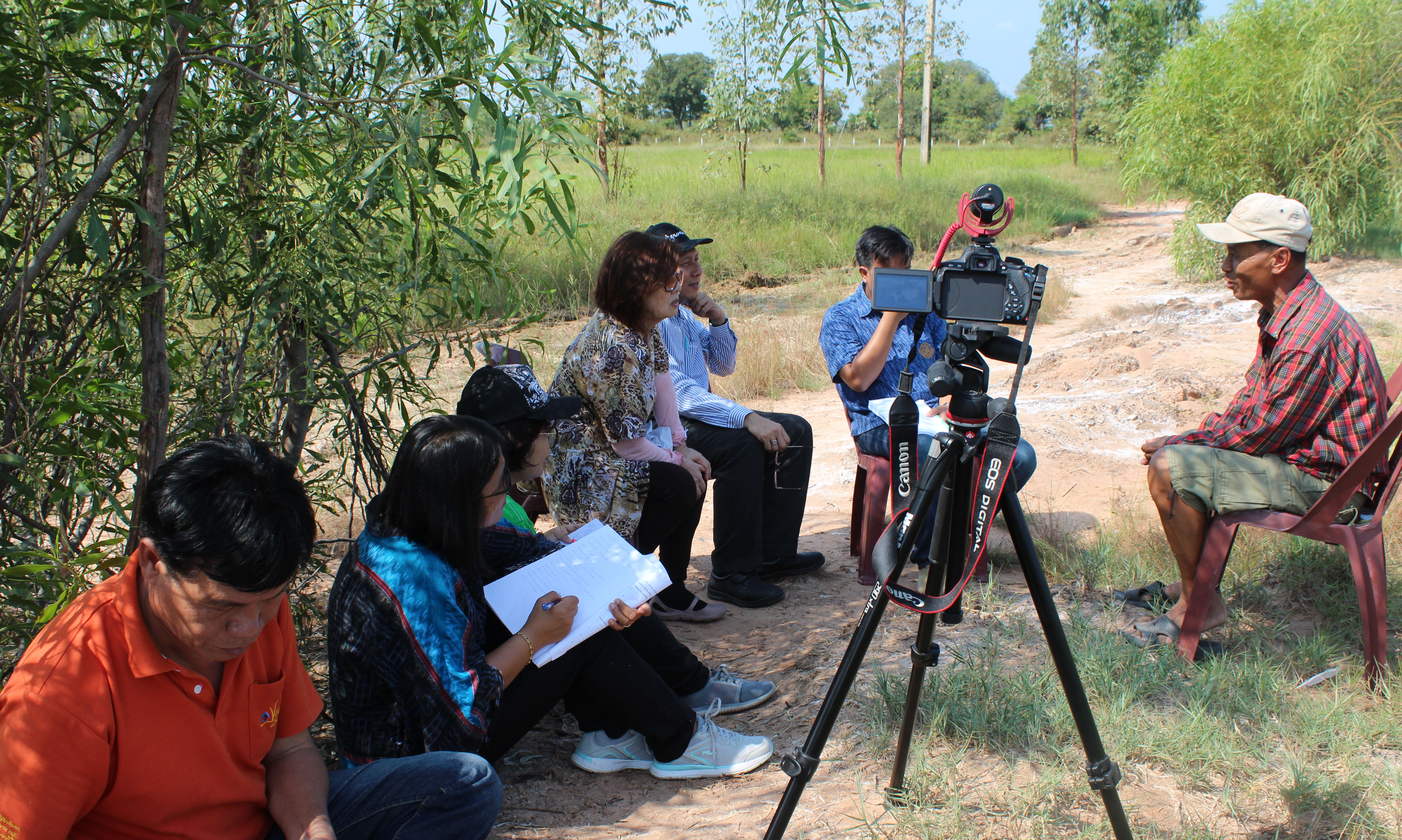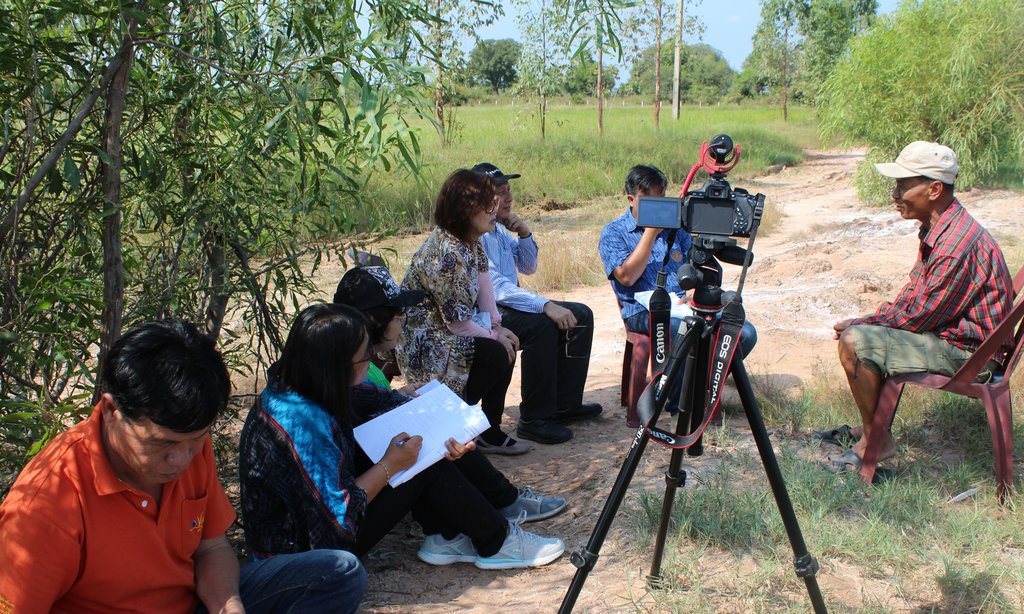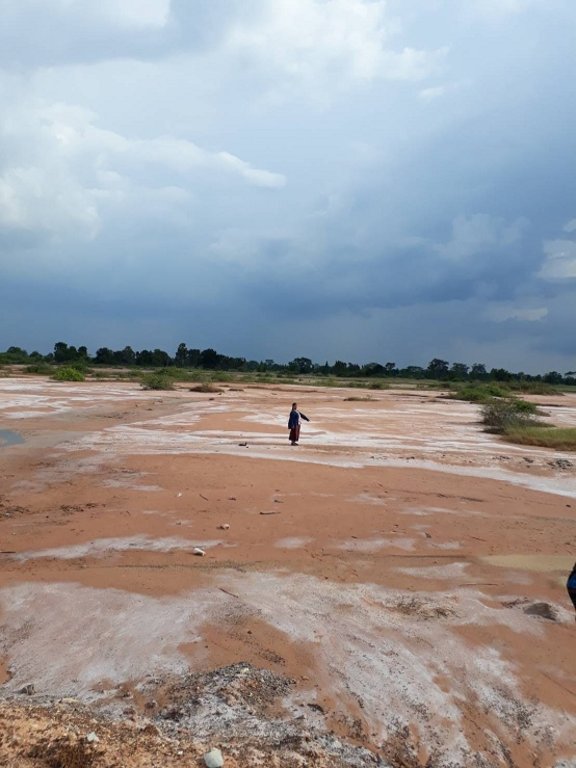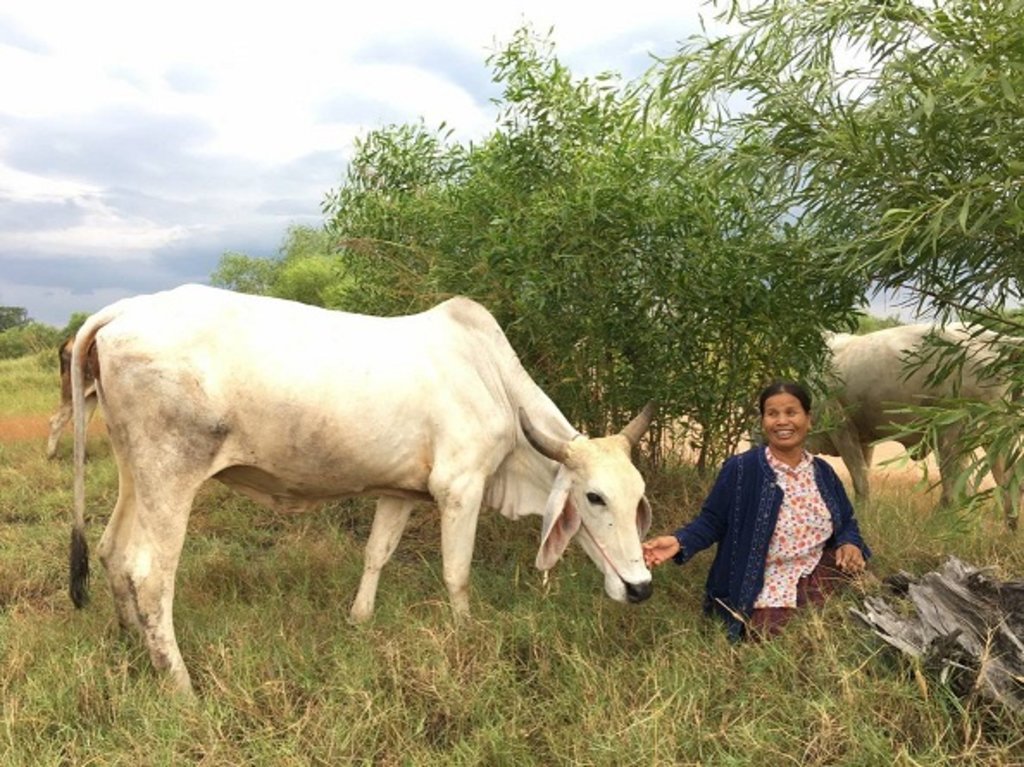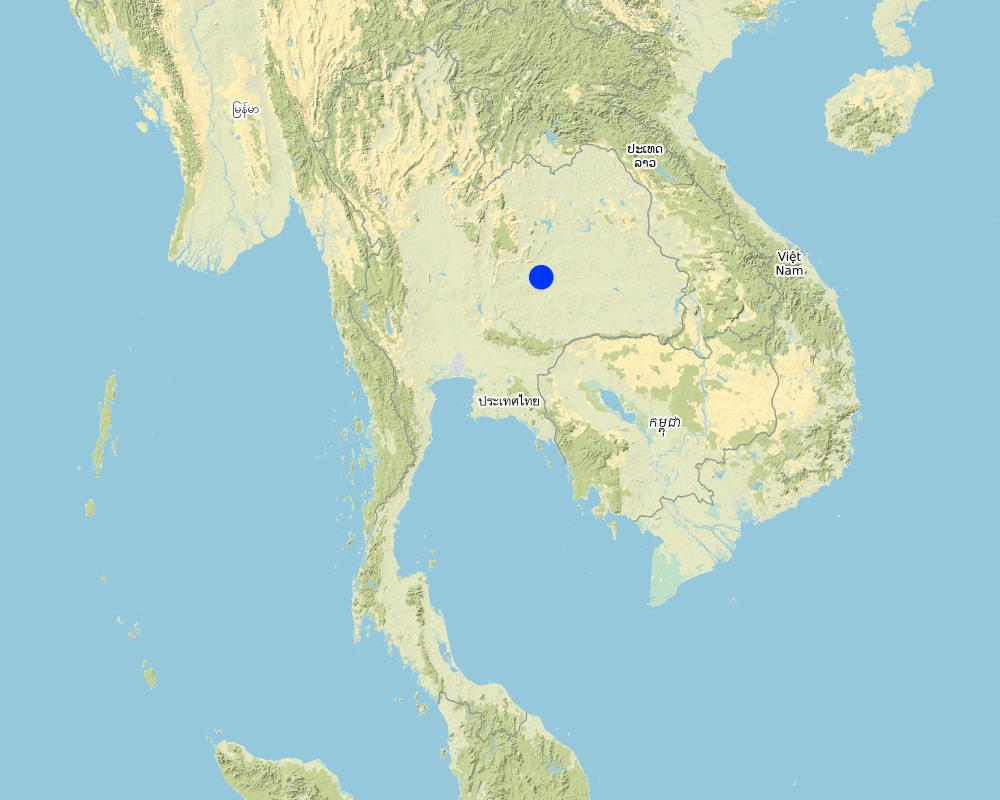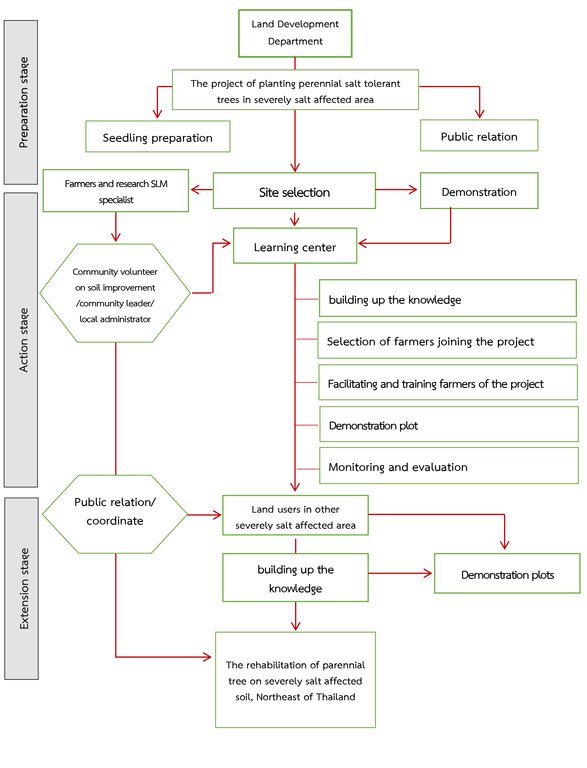Promotion of Acacia ampliceps on severely salt-affected soil [ไทย]
- ผู้สร้างสรรค์:
- การอัพเดท:
- ผู้รวบรวม: Phatranit Chuaysanoi
- ผู้เรียบเรียง: –
- ผู้ตรวจสอบ: Samran Sombatpanit, Rima Mekdaschi Studer, William Critchley
Planting Acacia ampliceps on severely salt-affected land.
approaches_4203 - ไทย
ดูส่วนย่อย
ขยายทั้งหมด ย่อทั้งหมด1. ข้อมูลทั่วไป
1.2 รายละเอียดที่ติดต่อได้ของผู้รวบรวมและองค์กรที่เกี่ยวข้องในการประเมินและการจัดเตรียมทำเอกสารของแนวทาง
ผู้ใช้ที่ดิน:
Tathaisong Nurean
+66-62-1521591
-
25 Ban Kok Sa-ard, Moo 10, T. Danchang, A. Buayai, Nakhon Ratchasima, Thailand
ไทย
ผู้ใช้ที่ดิน:
Panikom Chartee
+66-85-4395414
-
136/1 Moo 2, T. Danchang, A. Buayai, Nakhon Ratchasima
ไทย
ผู้ใช้ที่ดิน:
Salanok Mongkoen
+66-98-1181365
-
184 Moo 2, T. Danchang, A. Buayai, Nakhon Ratchasima
ไทย
ผู้ใช้ที่ดิน:
Palinee TubseKaew
+66-87-8706265
-
275 Moo 9, T. Danchang, A. Buayai, Nakhon Ratchasima
ไทย
Soil doctor volunteer:
Ponrat Kumpu
+66-85-6308129
-
106 Moo 9, T. Danchang, A. Buayai, Nakhon Ratchasima
Assistant of village leader:
Pawanna Pakorn
+66-86-2586926
-
34 Moo 9, T. Danchang, A. Buayai, Nakhon Ratchasima
ผู้เชี่ยวชาญ SLM:
Phaosrakhu Chakkaphan
+66-44-371397
yom42@hotmail.com
Technical Group for Land Development, Land Development Regional Office 3, Land Development Department
64 Moo 7, T. Joho, A. Muang, Nakhon Ratchasima 30310
ไทย
ผู้เชี่ยวชาญ SLM:
Oechaiyaphum Kaewjai
+66-83-5429245
issabellalala@gmail.com / KuKaewKaLDD@gmail.com
Chaiyaphum Land Development Station
268/5 Moo 14, T. Na Fai, A. Muang, Chaiyaphum
ไทย
ผู้เชี่ยวชาญ SLM:
Prachansri Saowanee
+66-44-371354
prachansri@gmail.com
Land Development Regional Office 3, Land Development Department
64 Moo 7, T. Joho, A. Muang, Nakhon Ratchasima 30310
ไทย
ผู้เชี่ยวชาญ SLM:
Phiprakon Apisit
+66-44-371397
Technical Group for Land Development, Land Development Regional Office 3, Land Development Department
64 Moo 7, T. Joho, A. Muang, Nakhon Ratchasima 30310
ไทย
ผู้เชี่ยวชาญ SLM:
Prawanna Prasit
+66-44-371397
Technical Group for Land Development, Land Development Regional Office 3, Land Development Department
64 Moo 7, T. Joho, A. Muang, Nakhon Ratchasima 30310
ไทย
National Consultant:
Arunin Somsri
ssarunin@gmail.com
Land Development Department
2003, 61 Phaholyothin Road, Ladyao, Chatuchak, Bangkok 10900
ไทย
ผู้เชี่ยวชาญ SLM:
ชื่อของโครงการซึ่งอำนวยความสะดวกในการทำเอกสารหรือการประเมินแนวทาง (ถ้าเกี่ยวข้อง)
Decision Support for Mainstreaming and Scaling out Sustainable Land Management (GEF-FAO / DS-SLM)ชื่อของโครงการซึ่งอำนวยความสะดวกในการทำเอกสารหรือการประเมินแนวทาง (ถ้าเกี่ยวข้อง)
Land Development Department LDD (Land Development Department LDD) - ไทย1.3 เงื่อนไขที่เกี่ยวข้องกับการใช้ข้อมูลที่ได้บันทึกไว้ผ่านทาง WOCAT
วันที่เก็บรวบรวมข้อมูล (ภาคสนาม):
09/10/2018
ผู้รวบรวมและวิทยากรหลักยอมรับเงื่อนไขเกี่ยวกับการใช้ข้อมูลที่ถูกบันทึกผ่านทาง WOCAT:
ใช่
2. คำอธิบายของแนวทาง SLM
2.1 การอธิบายแบบสั้น ๆ ของแนวทาง
Planting perennial salt-tolerant trees in the severely salt-affected area in Lam Satad of Chi-Mun watershed was introduced by the Land Development Department at A. Buayai, Nakhon Ratchasima. This project aimed at promoting the planting of Acacia ampliceps on an area of up to 4,665 rai (approx. 745 ha).
2.2 การอธิบายอย่างละเอียดของแนวทาง
การอธิบายอย่างละเอียดของแนวทาง:
Land rehabilitation through Acacia ampliceps planting on severely salt-affected soils has been a subproject of the LDD project on "Planting Perennial Salt-tolerant Trees in Salt-affected Areas in the Northeast of Thailand", which started in 1996. The area of Acacia ampliceps has extended further than 10,000 rai (approx. 1600 hectares) through public relations, demonstration plots, collaboration of community leaders, the local governmental administration, and community volunteers on soil improvement and land users.
The soil salinity map (LDD, 1995) shows that the severely salt-affected land in Northeast Thailand covers 475,200 rai. One of the technologies to address salinity is to decrease the saline shallow groundwater level by planting salt-tolerant trees - which are low input compared with engineering measures. The LDD has been extensively planting Acacia ampliceps through close collaboration and participation of stakeholders and demonstration plots in many severely salt-affected locations of several sub-watersheds, one of the sites being Lam Satad of Chi-Mun watershed. The objectives of the approach are (1) to extend the area of planting Acacia ampliceps to prevent and decrease salination, (2) to maximize the use of salt-affected land for a better environment and crop production, and (3) to extend the knowledge of vegetative measures for salinity control to land users and laymen.
The methods used are through (1) demonstration plots of Acacia ampliceps - planting 2-month-old seedlings in pits as single rows at 80 trees per rai (500 per hectare); (2) the land users got to know the approach through public relations media, local administration, community soil doctor volunteers on soil improvement, community leaders, SLM specialists, and researchers; (3) selection of interested land users under LDD requirements; (4) training of selected land users after joining the project, and (5) monitoring and evaluation after 1 year of planting.
Stakeholders involved are LDD researchers and SLM specialists responsible for establishing planting methods, preparation of land (land leveling and beds for planting), production of seedlings and carrying out demonstration plots, as well as monitoring and evaluation and training at the beginning of planting in new areas. The local administration and community soil doctor volunteers on soil improvement are involved in public relations, recommendations, and strengthening closer participation among farmers. Land users/farmers are to be trained and instructed to follow the technology by SLM specialists. They also participate in the monitoring and evaluation and persuade other land users/farmers to plant Acacia ampliceps.
The land users/farmers favour the technology because they have observed that salinity could be controlled, and they utilize the trees as shade for cattle and the tree branches for producing charcoal. Besides, the land users are self-organized as a group to watch and protect the young trees from being trampled by cattle. The disadvantage of Acacia ampliceps is its sensitivity to flash floods and forest fires. Furthermore, the direct production from the trees is low.
2.3 รูปภาพของแนวทาง
ข้อสังเกตทั่วไปเกี่ยวกับรูปภาพ:
This picture shows a group of Land Development Department officers, land users and stakeholders during knowledge-sharing through meeting and discussion.
2.4 วีดีโอของแนวทาง
ความคิดเห็น อธิบายสั้นๆ:
Conversation and lesson learned
วันที่:
09/10/2018
สถานที่:
Ban Nong Mek T. Danchang, A. Buayai, Nakhon Ratchasima
ชื่อของผู้ถ่ายวีดีโอ:
Jilayus Sommutram
2.5 ประเทศ ภูมิภาค หรือสถานที่ตั้งที่ได้นำแนวทางไปใช้
ประเทศ:
ไทย
ภูมิภาค/รัฐ/จังหวัด: :
Nakhon Ratchasima
ข้อมูลเฉพาะเพิ่มเติมของสถานที่ตั้ง:
Ban Kok Sa-ard, Moo 10 T. Danchang, A. Buayai
ความคิดเห็น:
The approach has been applied at Ban Kok Sa-ard M. 10 T. Danchang, A. Buayai, Nakhon Ratchasima
Map
×2.6 วันที่เริ่มต้นและสิ้นสุดของแนวทาง
ระบุปีที่เริ่ม:
2014
ถ้าไม่รู้ปีที่แน่นอนให้ประมาณวันที่ที่ริเริ่มใช้แนวทางนี้ :
น้อยกว่า 10 ปี (เร็วๆนี้)
การสิ้นสุดลง (ถ้าแนวทางไม่ได้ใช้อีกต่อไป):
2017
ความคิดเห็น:
This approach has been used since 2014 until now.
2.7 ประเภทของแนวทาง
- ใช้โครงงานหรือแผนงานเป็นฐาน
2.8 เป้าหมายหรือวัตถุประสงค์หลักของแนวทาง
The purpose is to scale-out the approach to persuade farmers on severely salt-affected land in other districts and provinces to grow Acacia ampliceps.
2.9 เงื่อนไขที่เอื้ออำนวยหรือเป็นอุปสรรคต่อการนำเทคโนโลยีภายใต้แนวทางนี้ไปปฏิบัติใช้
บรรทัดฐานและค่านิยมทางสังคม วัฒนธรรม ศาสนา
- เอื้ออำนวย
Farmers have mutual respect for the community leader and for each other.
การมีไว้ให้หรือการเข้าถึงแหล่งการเงินและบริการ
- เอื้ออำนวย
Farmers can access the financial resources through the housing fund.
การจัดตั้งระดับองค์กร
- เอื้ออำนวย
Public relations is done by Sub-district Administration Organization (SAO).
การร่วมมือหรือการทำงานประสานกันของผู้ลงมือปฏิบัติ
- เอื้ออำนวย
Community leaders, soil doctors (soil improvement volunteers) and successful farmers are working together.
นโยบาย
- เอื้ออำนวย
Thai government has a policy of rehabilitating salt-affected soils.
ความรู้เกี่ยวกับ SLM การเข้าถึงการสนับสนุนด้านเทคนิค
- เอื้ออำนวย
LDD officers educate farmers in study areas.
3. การมีส่วนร่วมและบทบาทของผู้มีส่วนได้ส่วนเสียที่เกี่ยวข้อง
3.1 ผู้มีส่วนได้ส่วนเสียที่เกี่ยวข้องในแนวทางนี้และบทบาท
- ผู้ใช้ที่ดินระดับท้องถิ่นหรือชุมชนระดับท้องถิ่น
The LDD officers, community leader, soil doctors (soil improvement volunteers) and local administration officers.
Provide knowledge of the technology.
- ผู้เชี่ยวชาญ SLM หรือที่ปรึกษาการเกษตร
SLM specialist, community leader, soil doctors (soil improvement volunteers) and local administration officers.
Technology transfer and implementation
- รัฐบาลระดับท้องถิ่น
Local administration / Community leader
Public relations and coordination
ถ้ามีผู้มีส่วนได้ส่วนเสียหลายคนที่เกี่ยวข้องให้ระบุหน่วยงานตัวแทน:
The LDD officers had extensively worked through close collaboration and participation of community leaders, soil doctors (soil improvement volunteers) and local administration officers.
3.2 การเกี่ยวข้องของผู้ใช้ที่ดินระดับท้องถิ่นหรือชุมชนระดับท้องถิ่นในช่วงต่างๆของแนวทาง
| ความเกี่ยวข้องของผู้ใช้ที่ดินระดับท้องถิ่นหรือชุมชนระดับท้องถิ่น | ระบุผู้ที่มีส่วนเกี่ยวข้องและอธิบายกิจกรรม | |
|---|---|---|
| การริเริ่มหรือการจูงใจ | ไม่ลงมือ | Training and demonstration plot was held in the study area. |
| การวางแผน | ปฏิสัมพันธ์ | Public hearing planning was set up before the beginning of the project. |
| การดำเนินการ | จ่ายเงินหรือสนับสนุนจากภายนอก | Some farmers were hired labourers in this project. |
| การติดตามตรวจสอบหรือการประเมินผล | ปฏิสัมพันธ์ | Volunteer soil doctors and community volunteers were in charge of the coordination. |
3.3 แผนผังแสดงขั้นตอนการทำงาน (ถ้ามี)
คำอธิบาย:
Flow chart shows three phases of the implementation and approach.
ผู้เขียน:
Mrs. Phatranit Chuaysanoi
3.4 การตัดสินใจเลือกใช้เทคโนโลยี SLM
ระบุผู้ที่ทำการตัดสินใจเลือกเทคโนโลยีมากกว่าหนึ่งวิธีไปปฏิบัติใช้:
- ผู้เชี่ยวชาญ SLM เป็นผู้ตัดสินใจหลัก ที่ติดตามให้คำปรึกษากับผู้ใช้ที่ดิน
การอธิบาย:
LDD started to do demonstration plots and educate farmers in 2014.
ระบุว่าการตัดสินใจตั้งอยู่บนพื้นฐานของ:
- การประเมินความรู้ SLM ที่ได้ทำการบันทึกไว้เป็นอย่างดี (การใช้ข้อมูลในการตัดสินใจ)
4. การสนับสนุนด้านเทคนิค การสร้างขีดความสามารถ และการจัดการด้านความรู้
4.1 การสร้างขีดความสามารถ / การอบรม
ได้มีการจัดอบรมให้แก่ผู้ใช้ที่ดินหรือผู้มีส่วนได้ส่วนเสียคนอื่น ๆ หรือไม่:
ใช่
ให้ระบุว่าใครเป็นผู้ได้รับการอบรม:
- ผู้ใช้ที่ดิน
ถ้าเกี่ยวข้อง ให้ระบุ เพศ อายุ สถานภาพ ชาติพันธุ์ เป็นต้น:
Mrs. Nurean Tathaisong, female, 56 years old, married, Thai
รูปแบบการอบรม:
- ใช้พื้นที่ทำการสาธิต
หัวข้อที่พูด:
The rehabilitation of severely salt-affected soils by growing Acacia ampliceps could reduce household expenditure and is easy to follow.
ความคิดเห็น:
Mrs. Nurean Thathaisong, female, 56 years old, married, Thai, has been playing an important role as a land user who received training and operated demonstration areas since 2014.
4.2 การบริการให้คำแนะนำ
ผู้ใช้ที่ดินมีการเข้าถึงการรับบริการให้คำปรึกษาหรือไม่:
ใช่
ระบุว่ามีบริการให้คำปรึกษาหรือไม่:
- ไปเยี่ยมชมสถานที่
การอธิบาย/แสดงความคิดเห็น:
1. LDD officers educate farmers in the study area.
2. There is cooperation among community leaders, volunteer soil doctors (soil improvement volunteers) and successful farmers.
4.3 การเสริมความแข็งแกร่งให้กับสถาบัน (การพัฒนาองค์กร)
สถาบันได้รับการจัดตั้งขึ้นมาหรือเสริมความแข็งแกร่งโดยแนวทางนี้หรือไม่:
- ไม่
4.4 การติดตามตรวจสอบและประเมินผล
การติดตามตรวจสอบและประเมินผลเป็นส่วนหนึ่งของแนวทางหรือไม่:
ใช่
ความคิดเห็น:
LDD officers are in charge of monitoring, investigating survival rates and planning for replanting in the next cropping season.
ถ้าตอบว่าใช่ แสดงว่าการจัดเตรียมเอกสารนี้มุ่งหวังที่จะเอาไปใช้สำหรับการติดตามตรวจสอบและประเมินผลใช่หรือไม่:
ใช่
ความคิดเห็น:
There are many issues in a document, which should be used for monitoring and evaluation.
4.5 การวิจัย
การวิจัยเป็นส่วนหนึ่งของแนวทางหรือไม่:
ใช่
ระบุหัวข้อเรื่อง:
- เทคโนโลยี
ให้ข้อมูลเพิ่มเติมและให้ระบุผู้ทำการวิจัย:
LDD researchers
5. การสนับสนุนด้านการเงินและวัสดุอุปกรณ์
5.1 ระบุงบประมาณประจำปีสำหรับแนวทาง SLM นี้
ถ้าหากว่างบประมาณประจำปีไม่เป็นที่ทราบแน่นอน ให้ระบุช่วงลงไป:
- < 2,000
แสดงความคิดเห็น (แหล่งของการระดมทุน ผู้บริจาคคนสำคัญ):
Land Development Department
5.2 การสนับสนุนด้านการเงิน / วัสดุอุปกรณ์ให้แก่ผู้ใช้ที่ดิน
ผู้ใช้ที่ดินได้รับการสนับสนุนด้านการเงิน / วัสดุอุปกรณ์ไปปฏิบัติใช้เทคโนโลยีหรือไม่:
ใช่
ถ้าใช่ ให้ระบุประเภทของการสนับสนุน เงื่อนไขและผู้จัดหามาให้:
Cost of compost, fertilizer, rice husks, Acacia ampliceps seedlings
5.3 เงินสนับสนุนสำหรับปัจจัยนำเข้า (รวมถึงแรงงาน)
- แรงงาน
| เห็นด้วยระดับไหน | ระบุเงินสนับสนุน |
|---|---|
| ได้รับการช่วยเหลือทางการเงินแบบเต็ม | Plantation and maintenance |
- การเกษตร
| ระบุปัจจัยนำเข้าที่ได้รับการสนับสนุน | เห็นด้วยระดับไหน | ระบุเงินสนับสนุน |
|---|---|---|
| เมล็ด | ได้รับการช่วยเหลือทางการเงินแบบเต็ม | Free seedlings |
| ปุ๋ย | ได้รับการช่วยเหลือทางการเงินแบบเต็ม | Free compost, rice husk and chemical fertilizer with 15-15-15 formula |
- วัสดุสำหรับการก่อสร้าง
| ระบุปัจจัยนำเข้าที่ได้รับการสนับสนุน | เห็นด้วยระดับไหน | ระบุเงินสนับสนุน |
|---|---|---|
| farm rigged | ได้รับการช่วยเหลือทางการเงินแบบเต็ม | Reshape of farm ridge |
ความคิดเห็น:
There were many subsidies such as labour, agricultural inputs, and construction material, which are free for farmers who have engaged in this project.
5.4 เครดิต
มีการจัดหาเครดิตมาให้ภายใต้แนวทาง SLM หรือไม่:
ไม่ใช่
5.5 แรงจูงใจหรือเครื่องมืออื่น ๆ
แรงจูงใจหรือเครื่องมืออื่น ๆ ได้ถูกนำไปใช้ส่งเสริมการใช้เทคโนโลยี SLM หรือไม่:
ไม่ใช่
6. การวิเคราะห์ผลกระทบและการสรุป
6.1 ผลกระทบของแนวทาง
ทำให้ผู้ใช้ที่ดินระดับท้องถิ่นมีอำนาจขึ้น ปรับปรุงการเข้าร่วมของผู้มีส่วนได้ส่วนเสียให้ดีขึ้นหรือไม่:
- ไม่ใช่
- ใช่ เล็กน้อย
- ใช่ ปานกลาง
- ใช่ อย่างมาก
To develop food security and reduce farm household
ช่วยในการตัดสินใจโดยดูจากหลักฐาน ได้หรือไม่:
- ไม่ใช่
- ใช่ เล็กน้อย
- ใช่ ปานกลาง
- ใช่ อย่างมาก
Learning center and source of information in the decision-making process on technology adoption
ช่วยให้ผู้ใช้ที่ดินนำเอาเทคโนโลยี SLMไปใช้และบำรุงรักษาสภาพไว้ได้หรือไม่:
- ไม่ใช่
- ใช่ เล็กน้อย
- ใช่ ปานกลาง
- ใช่ อย่างมาก
Farmers were taking care of technology because it causes of expenditure reduction
ระดมกำลังหรือปรับปรุงการเข้าถึงแหล่ง เงินทุนสำหรับการดำเนินการ SLM หรือไม่:
- ไม่ใช่
- ใช่ เล็กน้อย
- ใช่ ปานกลาง
- ใช่ อย่างมาก
It would be a guarantee for loan deposit
ปรับปรุงความรู้และความสามารถของผู้ใช้ที่ดินในการดำเนินการ SLM หรือไม่:
- ไม่ใช่
- ใช่ เล็กน้อย
- ใช่ ปานกลาง
- ใช่ อย่างมาก
Self-adaptation and changing of SLM patterns
ปรับปรุงความรู้และความสามารถของผู้มีส่วนได้ส่วนเสียคนอื่น ๆ ให้ดีขึ้นหรือไม่:
- ไม่ใช่
- ใช่ เล็กน้อย
- ใช่ ปานกลาง
- ใช่ อย่างมาก
Government agencies and the private sector development patterns of SLM
นำไปสู่การเข้าถึงเรื่องน้ำและสุขาภิบาลได้ดีขึ้นหรือไม่:
- ไม่ใช่
- ใช่ เล็กน้อย
- ใช่ ปานกลาง
- ใช่ อย่างมาก
According to technology adoption, it could result in desalinization and income enhancement
6.2 แรงจูงใจหลักของผู้ใช้ที่ดินเพื่อที่จะนำ SLM ไปปฏิบัติใช้
- การผลิตที่เพิ่มขึ้น
Increase of arable land
- การเสื่อมของที่ดินลดลง
Desalinization
- ภาระงานลดลง
Increase of pasture land
6.3 ความยั่งยืนของกิจกรรมของแนวทาง
ผู้ใช้ที่ดินสามารถทำให้สิ่งต่างๆ ที่ได้ปฏิบัติใช้โดยแนวทางนี้ยั่งยืนได้หรือไม่ (โดยไม่มีการสนับสนุนจากภายนอก):
- ใช่
ถ้าตอบว่าใช่ ให้อธิบายว่าอย่างไร :
Most farmers have a good understanding of the rehabilitation of Acacia ampliceps on severely salt-affected soils. Moreover, farmers can get benefit of expenditure reduction through utilization of tree branches as charcoal.
6.4 จุดแข็งและข้อได้เปรียบของแนวทาง
| จุดแข็ง / ข้อได้เปรียบของแนวทางในทัศนคติของผู้ใช้ที่ดิน |
|---|
| 1) Acacia ampliceps is a perennial salt-tolerant tree, which can grow well in the severely salt-affected area. |
| 2) Desalinization resulted from Acacia ampliceps plantation after 2 years of planting, native grasses return and become grazing land. |
| 3) Tree branches of Acacia ampliceps could be utilized as charcoal; and the land was changed from barren to trees that become shading. |
| 4) Soil doctors (soil improvement volunteers) were in charge of coordination. |
| จุดแข็ง / ข้อได้เปรียบของแนวทางในทัศนคติของผู้รวบรวมหรือวิทยากรหลัก |
|---|
| 1) There were LDD officers working with a community leader, soil doctors (soil improvement volunteers) and SAO (Sub-district Administration Organization) officers, who can suggest and support necessary information to the farmer. |
| 2) Land Development Department operates demonstration plots. |
6.5 จุดอ่อน / ข้อเสียเปรียบของแนวทางและวิธีในการแก้ไข
| จุดอ่อน / ข้อเสียเปรียบในทัศนคติของผู้ใช้ที่ดิน | สามารถแก้ไขปัญหาได้อย่างไร |
|---|---|
| 1) If a farmer does not engage with this project, he will have no knowledge how to plant Acacia ampliceps in the farm. Moreover, he will not know where to buy Acacia ampliceps seeds. | The LDD has extensively worked through close collaboration and participation of community leader, soil doctors (soil improvement volunteers) and local administration officers on public relations and persuade other land users/ farmers to plant Acacia ampliceps. |
| จุดอ่อน / ข้อเสียเปรียบในทัศนคติของผู้รวบรวมหรือวิทยากรหลัก | สามารถแก้ไขปัญหาได้อย่างไร |
|---|---|
| 1) If a farmer doesn’t engage with this project, they don’t have knowledge how to desalinization by planting Acacia ampliceps. Moreover, they don’t know that severely salt-affected soils become less saline to become rice field after 3 years of planting Acacia ampliceps. | There must have training/ suggesting farmers to know the benefits of Acacia ampliceps planting. |
7. การอ้างอิงและการเชื่อมต่อ
7.1 วิธีการหรือแหล่งข้อมูล
- การสัมภาษณ์กับผู้ใช้ที่ดิน
Six persons about Acacia ampliceps plantation
- การสัมภาษณ์ผู้เชี่ยวชาญด้าน SLM หรือผู้ชำนาญ
Seven LDD officers
7.2 การอ้างอิงถึงสิ่งตีพิมพ์
ชื่อเรื่อง ผู้เขียน ปี ISBN:
Land Development Department
ช่องทางในการสืบค้น และราคา:
http://www.ldd.go.th/
7.3 เชื่อมโยงกับข้อมูลที่มีอยู่บนออนไลน์
ชื่อเรื่องหรือคำอธิบาย:
Where the land is greener - Case Studies and Analysis of Soil and Water Conservation Initiatives Worldwide
URL:
http://www.ldd.go.th/www/lek_web/
ลิงก์และโมดูล
ขยายทั้งหมด ย่อทั้งหมดลิงก์
ไม่มีลิงก์
โมดูล
ไม่มีโมดูล


